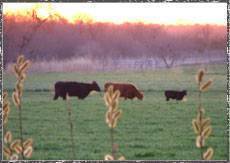S Diamond Angus is a family operation of the Siebert's, Kim and Lindy. Families continue to grow and ours is no different our help continues from our daughter Samantha, her husband Justin Haack and their boys Riley and Kayde. Also our son Kendall, his wife Meghan and Easton. We have been chasing cows and raising crops since 1979. Currently they operate on 1200 acres of farm ground and run 120-140 pairs, 60+ of each breed, on a variety of pasture situations. A surplus of winter-feed, crop residue, and a love for cattle is what began this operation. Pasture is hard to come by so innovation is more the norm than rare here.
Kim's father owned and operated a feedlot since before Kim existed, so feed efficiency, performance, and carcass traits were always at the forefront of talking cattle. This is what Kim heard from the beginning and so it is little wonder that they have always been important. Carcass and feedlot testing of our steer calves began with the 1985 calf crop and continues thru today without interruption. Ultrasound data on the bulls began with the 1999 calf crop and heifers with the 2001 crop. The 5-year average for ribeye is 1.12 inches per 100 pounds of body weight. For example a 1200 pound bull would have a 13.4 inch ribeye. The bulls are fed for red meat gain and leave with less than .25 inches of back fat. Gain is figured from weaning weight to yearling weight just like your commercial cattle and has averaged 3.33 pounds per day for 162 days the past 5 years. All this on a high-roughage growing ration designed for 2.75 pounds of gain.
As with any young couple starting out, money was not in abundance. AI became the herd bull and continues to be. 75-85% of each calf crop is AI sired. This makes fertility a trait of premium importance. Calving begins around January 25th. 75% of our calves are born within 30 days of our first due date. This also shows through in our bull sale where the actual scrotal measurements have averaged 37.7 the last 5 years on yearling bulls.
EPD's have always played an important role. It is the only tool we have to compare one herd to another. Although they are not perfect or absolute, EPD's are still an important tool. Our average WW and YW EPD's for the females who calved this spring rank in the top 20-25 % in both breeds, with milk being in the top half. Herd averages like these don't happen overnight, especially when you consider that in the black females we bred this spring, 88% carry our prefix back 3 generations. In our red cattle, even with a 10 year later start, 88% of the herd was born here and 79% are the second generation or more with our prefix.
All of these traits and measurements are important but no matter how well the numbers read one must still enjoy being with your cattle. That means both appearance and disposition. Chopping thistles or cutting trees in a pasture is a lot more fun when attractive pairs are milling around you. |


The Seibert Family

|



